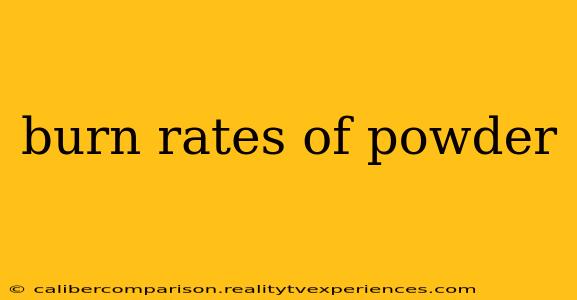Gunpowder, the propellant behind countless firearms and historical events, has a fascinating characteristic: its burn rate. This seemingly simple concept plays a crucial role in determining the performance and safety of any firearm. Understanding burn rates is essential for both enthusiasts and professionals alike, from reloaders fine-tuning their recipes to historians studying ancient weaponry. This guide delves into the complexities of gunpowder burn rates, exploring the factors influencing them and the implications for various applications.
What is Burn Rate?
The burn rate of gunpowder refers to the speed at which the propellant burns. It's typically measured in millimeters per second (mm/s) or inches per second (in/s) and is significantly influenced by the propellant's composition, particle size, density, and the surrounding pressure and temperature. A faster burn rate means the powder consumes itself more quickly, generating a rapid increase in pressure within the firearm's chamber. Conversely, a slower burn rate leads to a more gradual pressure rise.
Factors Affecting Gunpowder Burn Rate
Several key factors interact to determine the final burn rate of a specific gunpowder:
1. Composition:
The chemical makeup of the gunpowder significantly impacts its burn rate. Different formulations, including variations in the ratios of nitrate, charcoal, and sulfur, result in dramatically different burning characteristics. Modern smokeless powders, for instance, exhibit a much wider range of burn rates compared to traditional black powder. The addition of other chemical compounds can further modify the burn rate, influencing factors like stability and sensitivity.
2. Particle Size and Shape:
The physical characteristics of the gunpowder grains are crucial. Smaller grains generally burn faster than larger ones due to increased surface area exposed to the flame. The shape of the grains also plays a role; for example, spherical grains might burn more consistently than irregularly shaped ones. Modern smokeless powders employ diverse grain shapes (ball, flake, extruded) to achieve specific burn rate profiles.
3. Density:
The density of the powder directly affects its burn rate. Higher density powders tend to burn slower because the increased compactness reduces the surface area available for combustion. This is a critical consideration in reloading, where achieving consistent powder density is crucial for consistent performance.
4. Pressure and Temperature:
The pressure and temperature within the firearm's chamber significantly influence the burn rate. Higher pressures generally accelerate the burn rate, leading to a faster pressure rise. Similarly, higher temperatures can increase the rate of combustion. These factors interact dynamically during the firing cycle.
Implications of Different Burn Rates
The selection of gunpowder with an appropriate burn rate is paramount for firearm safety and performance.
Fast Burn Rates:
- Higher pressure: Faster burn rates produce a sharp, rapid pressure spike. This is suitable for small cartridges and handguns where quick pressure build-up is needed for optimal performance. However, excessively fast burn rates can lead to dangerous over-pressurization.
- Increased recoil: The rapid pressure increase translates to greater recoil.
- Higher risk of over-pressure: Improperly matched fast-burning powder in a larger cartridge can result in catastrophic chamber pressure exceeding the firearm's design limits.
Slow Burn Rates:
- More gradual pressure rise: Slower burn rates generate a gentler pressure curve, ideal for larger cartridges and rifles where a sustained push on the bullet is required for accurate, long-range shots.
- Reduced recoil: The slower pressure increase results in less recoil.
- Improved accuracy (often): The more controlled pressure curve can contribute to improved accuracy, though other factors are equally important.
Conclusion: A Critical Parameter
Understanding gunpowder burn rates is vital for safe and effective use of firearms. This multifaceted characteristic is a function of numerous factors, and precise control over these factors is essential for both ammunition manufacturers and reloaders. Choosing the wrong powder with an inappropriate burn rate can lead to serious consequences, highlighting the importance of careful selection and adherence to safety guidelines. Further research into specific powder types and their characteristics is encouraged for those involved in reloading or other activities that require a detailed understanding of propellant behavior.

